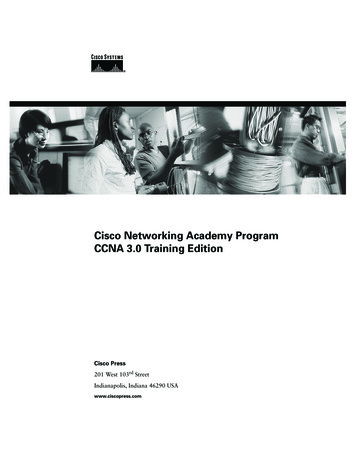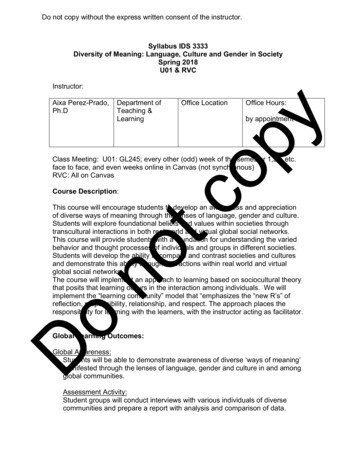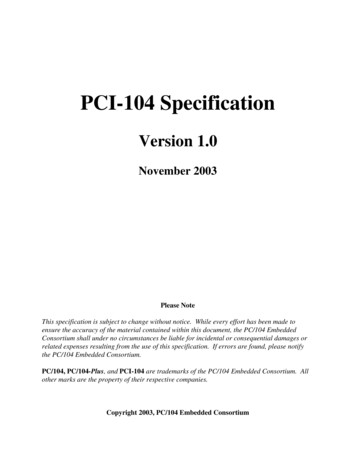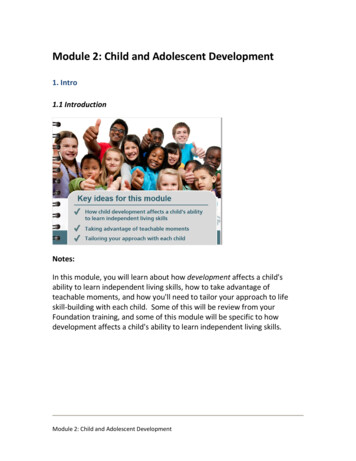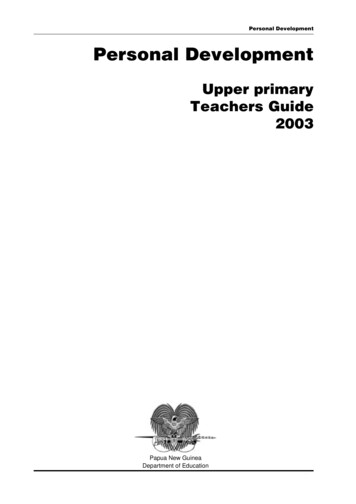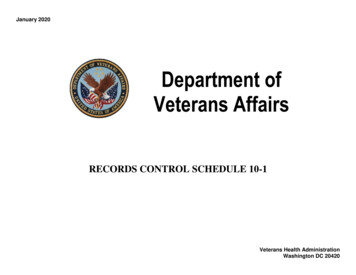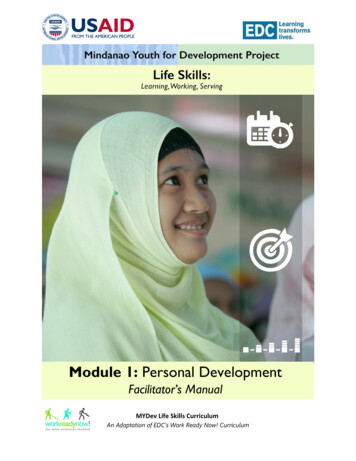
Transcription
Module 1: Personal DevelopmentFacilitator’s ManualMYDev Life Skills CurriculumAn Adaptation of EDC’s Work Ready Now! Curriculum
Module 1: Personal DevelopmentFacilitator’s ManualModule 1: Personal Development“Mas mabuting pinag‐iisipan ang kinabukasanhabang ikaw ay nasa kasalukuyan.”One better thinks of the future while in the present.Personal Development ObjectivesBy the end of the module participants will: Identify their values, skills and personal strengths and weaknessesLink personal values to their daily livesIdentify goalsMake a plan to reach their goalsAppreciate different learning styles and identify different learning strategiesModule Overview Activity Time Session 1: Values and Skills2 hrs 10 mins1: Introductory Activity & Learner’s Reflection2. Values, Beliefs & Qualities3: We Are All Unique4: My Skills and Qualities30 min40 min30 min30 min Session 2: Setting & Achieving Goals1 hr 55 min5: Introduction & Process for Setting and Achieving Goals 1 hr 30 min6. Session 1&2 Review & Application – Values, Skills, Goals 25 min&2 hr 15 mins PlanningSession 3: Learning New Skills2: Sessions 1 & 2 Review – Values, Skills, Goals & Planning20 min7: Learning Style Assessment25 min8:2: LearningSessions Strategies1 & 2 Review – Values, Skills, Goals & Planning40 min20 min9: Session 3 Review & Application – Learning New Skills1 hr 10 min2: Sessions 1 & 2 Review – Values, Skills, Goals & PlanningTotal Time:20min20 min6 hrminsMindanao Youth for Development Project Life Skills Curriculum, adapted from EDC’s WRN! Curriculum 2016 Education Development Center, Inc. All Rights Reserved.Page 2
Module 1: Personal DevelopmentFacilitator’s ManualModule 1 Materials and Preparation Basic training materials: manila paper, markers, tape, A4 paper, glue, scissors, old magazines ornewspaper. Make sure participants have their Participant’s Handbook available.Session 1: Paper ballPrepare a manila paper with a blank Learner’s Reflection table as sampleLearner’s ReflectionReview objectives of the modulePrepare a manila paper with the proverb (below) to discuss with learners Handout 1.1: Examples of Values, Beliefs and Desirable QualitiesPrepare 4 signs on manila paper or meta cards – Strongly Agree, Somewhat Agree, SomewhatDisagree and Strongly Disagree Review the list of statements to read to participants Handout 1.2: My Skills and QualitiesSession 2: Prepare a manila paper with the drawing of a tree with all its parts stating what they represent:values/skills (roots), strength (trunk), goals in the near future (branches), obstacles (thorns),resources needed (leaves), goals in the far away future (fruits) Handout 1.3: Setting and Achieving Goals Handout 1.4: Steps for Achieving My Goals Review key concepts of each activity covered in this sessionSession 3: Handout 1.5: How Do You Learn Best? Handout 1.6: Learning My Way Review key concepts for each activity Cut-out scenarios to be given to each group Make 1 copy per participant of the End of Module AssessmentMindanao Youth for Development Project Life Skills Curriculum, adapted from EDC’s WRN! Curriculum 2016 Education Development Center, Inc. All Rights Reserved.Page 3
Module 1: Personal DevelopmentFacilitator’s ManualSESSION 1: VALUES AND SKILLS Activity 1: Introductory Activity Objectives - By the end of the activity, participants will be able to:a. Describe the topics that are important for planning one’s future Time Required: 30 minutes Methodology: large group discussion Materials and Preparation: manila paper, markers, tape Paper ballPrepare a manila paper with a blank Learner’s Reflection table as sampleLearner’s ReflectionReview objectives of the modulePrepare a manila paper with the proverb (below) to discuss with learnersSteps:1. Welcome participants to Module 1: Personal Development and quickly review the keypoints and ground rules covered during the introduction to the program (goals andcontent of the life skills program, rules, group roles such as timekeeping, etc.). Haveparticipants pass a paper ball or other object to one another. The person who catches itshould mention one main point covered during the introductory session. Continue untilthe main concepts are covered, providing input as needed.(5 min)2. Ask participants to think about the proverb found at the beginning of Module 1: “Masmabuting pinag-iisipan ang kinabukasan habang ikaw ay nasa kasalukuyan”(One better thinks of the future while in the present). What is the meaning?Explain that during this module they are going to identify what is important to themand how they can grow and move ahead. Ask them what they think the relevance isbetween the proverb and the module. How does it relate to real life? The first sessionwill focus on the first objective and will include identifying our own values, beliefs,interests, and strengths and weaknesses. State the main Key Topics of this session(below).(10 min) Key Topics Values, beliefs and qualities Skills and qualities assessmentMindanao Youth for Development Project Life Skills Curriculum, adapted from EDC’s WRN! Curriculum 2016 Education Development Center, Inc. All Rights Reserved.Page 4
Module 1: Personal DevelopmentFacilitator’s Manual3. Have learners take the Learner’s Reflection explaining that this is not a test but is away to see what they already know or do not know about the topics.Ask learners to go to the Learner’s Reflection of Module 1 in their Participant’s Handbook.Using the manila paper that you prepared with a blank table, explain the meaning of eachcolumn (1,2,3,4). Tell them that you will read a few statements. For each statement theyneed to check the column that best describes them. Stress the importance of answeringhonestly and independently.Read one statement at a time and allow time for learners to think of an answer.(15 min)Mindanao Youth for Development Project Life Skills Curriculum, adapted from EDC’s WRN! Curriculum 2016 Education Development Center, Inc. All Rights Reserved.Page 5
Module 1: Personal DevelopmentFacilitator’s ManualLearner’s Reflection: Module 1 Personal DevelopmentThis is not a test but is a way for us to see what you already know or do not know about the topics. I will read askill that is listed in the left column. Think about yourself and your experience. I will read the statements acrossthe top. Check the column that best represents your situation. The results will guide me in helping you learnmore about this topic.Ang mga katanungan dito ay hindi test. Ito ay isang paraan upang malaman natin ang inyong kaalaman, kasanayano kakayahan tungkol sa paksang ito. Lahat ng inyong mga kasagutan ay ating tatanggapin.Babasahin ko ang bawat tanong. Magbalik- tanaw sa inyong mga karanasan at i- tsek ang sagot na naaangkopsa inyong sitwasyon. Ang inyong kasagutan ay magiging gabay ko sa pagpapalawak ng inyong kaalaman tungkolsa paksang ito.My experienceKnowledge, skills andabilitiesKaalaman, kasanayanat kakayahan1I don’t have anyexperience doingthis.Wala akongkaranasan sapaggawa nito234I have very littleI have someI have a lot ofexperience doingexperience doing this. experience doing this.this.Mayroon akongMarami akongkaranasan sa paggawa karanasan sa paggawaKakaunting –nitonitokakaunti lamang angaking karanasan sapaggawa nitoIdentifying my ownstrengths, interests &challenges / Pagtukoysa sariling kakayahan,interes at mgapagsubokSetting a goal for myself/ Magkaroon ng sarilinglayunin sa buhayMaking a plan to reacha goal / Gumawa ngplano upang maabotang layuninFollowing the steps of aplan / Sumunod saitinakdang planoPaying attention toprogress on followingthe plan and achievingthe goal / Pagbigaypansin sa progreso ngplano para makamitang layuninMindanao Youth for Development Project Life Skills Curriculum, adapted from EDC’s WRN! Curriculum 2016 Education Development Center, Inc. All Rights Reserved.Page 6
Module 1: Personal DevelopmentFacilitator’s ManualUnderstanding differentways of learning newskills and ideas /Maintindihan ang iba’tibang paraan upangmatutunan ang mgabagong kakayahan atideyaIdentifying and usingstrategies to help melearn better / Matukoyat magamit ang mgapamamaraan paramapalawak angkaalamanMindanao Youth for Development Project Life Skills Curriculum, adapted from EDC’s WRN! Curriculum 2016 Education Development Center, Inc. All Rights Reserved.Page 7
Module 1: Personal DevelopmentFacilitator’s Manual Activity 2: Values, Beliefs & Qualities Objectives - By the end of the activity, participants will be able to:a. Identify personal valuesb. Relate personal values to family and employer Time Required: 40 minutes Methodology: individual work, small group work, large group discussion Materials and Preparation: manila paper, markers, tape Handout 1.1: Examples of Values, Beliefs and Desirable QualitiesSteps:1. Ask participants to think about someone they respect and who served as his or her rolemodel. What made that person so special to him or her?Ask participants to form small groups of three and let them discuss the peoplethey have chosen. Ask them to write down the words that describe the person(e.g. passionate, honest, hardworking, committed, humorous ) on manila paper.Post the groups’ outputs and review with the large group.(20 min)2. Explain to participants that our values guide us in planning for our future. Our values andbeliefs serve as a foundation for choices we make, jobs we are interested in, and how webehave at work and in our personal lives.Have participants go to Handout 1.1: Examples of Values, Beliefs and Desirable QualitiesParticipant’s Handbook. Show that there are many values, beliefs and desirable qualitiesthat influence the way people behave. Read the list together and ask participants if any ofthe words they wrote on the manila paper are on the list.(5 min)3. Ask participants to fill in the table in their Handbook, first choosing the 5 most importantpersonal values for themselves then choose the top 5 values for their family/friends, andfinally what they think the 5 most important values should the employers have?Discuss participants’ responses in the group using the debriefing questions below:(15 min)Mindanao Youth for Development Project Life Skills Curriculum, adapted from EDC’s WRN! Curriculum 2016 Education Development Center, Inc. All Rights Reserved.Page 8
Module 1: Personal DevelopmentFacilitator’s ManualDebriefing Questions:a.Identify the most common values by reading through the list and havingparticipants raise their hands if the value read was one of their top 5.b.Do the same for the employer column. What values seem to be themost important for employers and why? Are they similar or differentfrom their own?(Many of the values are similar but the employer might put moreemphasis on values that will help get his or her business ahead.)c.Given the values of employers, how should you behave when working?(Emphasize that it is important to be aware of what employers valueand to try and behave in a way that reflects those values. For example,employers might value honesty. It is important for employees to behonest.)d.Think about the things you do on a regular basis. What values arereflected in your daily activities?(Often the things you are involved in or like to do reflect your values.) LOW LITERACY ALTERNATIVES Instead of using Handout 1.1, use the list of values generated bythe participants in the previous steps. Ask them to think about whatis important to them and ask if they want to add to the list. Theycan discuss with a partner what their own values are, what theythink employers’ values are, and those of their family and friends.Pairs then share with the large group. Use some of the debriefingquestions to guide the discussion.Mindanao Youth for Development Project Life Skills Curriculum, adapted from EDC’s WRN! Curriculum 2016 Education Development Center, Inc. All Rights Reserved.Page 9
Module 1: Personal DevelopmentFacilitator’s Manual Handout 1.1: Examples of Values, Beliefs & Desirable QualitiesFor each column, choose the top 5 values and mark them with an MILY/FRIENDSEMPLOYERMindanao Youth for Development Project Life Skills Curriculum, adapted from EDC’s WRN! Curriculum 2016 Education Development Center, Inc. All Rights Reserved.Page 10
Module 1: Personal DevelopmentFacilitator’s Manual Activity 3: We Are All Unique Objectives -By the end of the activity, participants will be able to:a. Share some of their values, beliefs and interestsb. Realize that while there are similarities and differences amongst everyone, we are allunique individualsc. Develop self-worth Time Required: 30 minutes Methodology: large group activity, pair work, and discussion Materials and Preparation: manila paper, markers, tape Prepare 4 signs on manila paper or meta cards – Strongly Agree, Somewhat Agree,Somewhat Disagree and Strongly Disagree Review the list of statements to read to participantsSteps:1. Hang up the signs in each corner of the room. Explain that you will read a statement andthe participants will go to the corner of the room that says strongly agree, somewhatagree, somewhat disagree or strongly disagree, depending on their own view of thestatement.(5 min)2. Statements should be prepared beforehand and can reflect values, beliefs, interests,abilities, etc. Examples include: I believe respect is the most important I want to work in an office.value. I think people should be on time to work. I like to be a leader. Spending time with your family and I prefer socializing with friends in myfriends will keep you healthy.free time. I am a hard worker. I like action movies. I am well organized. I like to play sports. I like to read. I always respect my elders. I want to start my own business. I am a good problem solver. I want to work in construction. Everybody should be heard.For some of the items, ask participants why they chose their responses. Emphasize thateverybody has their own opinions, feelings, interests and skills. Sometimes we havesimilarities with others and sometimes we have differences. We are all unique.(15 min)Mindanao Youth for Development Project Life Skills Curriculum, adapted from EDC’s WRN! Curriculum 2016 Education Development Center, Inc. All Rights Reserved.Page 11
Module 1: Personal DevelopmentFacilitator’s Manual3. Pair-share activity: Each learner will work with a classmate, who may be his/her closestfriend or anyone from the group that he/she is comfortable to work with. Given thecategories below, each will share his/her own thoughts after the other.a. Interestsb. Likesc. Ambitionsd. Perfect leadere. Principles in lifef. Beliefsg. Hobbiesh. Talentsi. Person you look-up to as a role model(10 min)Mindanao Youth for Development Project Life Skills Curriculum, adapted from EDC’s WRN! Curriculum 2016 Education Development Center, Inc. All Rights Reserved.Page 12
Module 1: Personal DevelopmentFacilitator’s Manual Activity 4: My Skills and Qualities Objectives -By the end of the activity, participants will be able to:a. Identify skills and qualities that are important to them in general and for workb. Assess their own skills and qualitiesc. Begin to determine next steps in improving skills and qualities Time Required: 30 minutes Methodology: individual work, large group discussion Materials and Preparation: manila paper, markers, tape Handout 1.2: My Skills and QualitiesSteps:1. Explain to participants that values influence how we spend our time and also lead us todeveloping skills and qualities that are useful for work.Ask learners to go to Handout 1.2: My Skills and Qualities in their Participant’sHandbook. Ask them to choose the top 6 skills or qualities that they would like to use ina job and copy them in their notebooks. Then have them rate themselves for all the 6skills/qualities that they selected (using the 4 columns in the Handout). These skills andqualities can apply to work, to your education, or personal life. Emphasize that thisactivity is for themselves and they are not being given marks or being rated. It is to helpthem identify their skills and qualities.(10 min)2. Ask participants to draw a line down the center, creating 2 columns. They should writeStrengths on the left side and Areas for Improvement on the right side (use the manilapaper prepared beforehand to show where the line should go). They should look at the6 items they had circled at the beginning. If they rated themselves as very good or goodfor a skill/quality, it means it is a Strength. If they rated themselves not so good or needsto improve a lot, it is an Area for Improvement.(5 min)Have learners think about their results:a. How did I rate myself in each of the 6 areas that I selected?b. What skills/qualities can I improve under Areas of Improvement to turn them intoStrengths?Mindanao Youth for Development Project Life Skills Curriculum, adapted from EDC’s WRN! Curriculum 2016 Education Development Center, Inc. All Rights Reserved.Page 13
Module 1: Personal Development3. Process the exercise with the whole group by asking them:Facilitator’s Manual(5 min)Debriefing Questions:a. How did this activity of selecting and assessing your skills and qualities helpyou?(It helps me identify what skills/qualities are important to me, my strengths andweaknesses in particular areas, possible areas of employment and next steps.)b. Were all of their preferred skills/qualities in the strengths column? For those that werenot, what does one do?(Need to set goals and make a plan of action; identify steps to take to improve the skill –resources, training, )Emphasize that everybody has strengths and areas for improvement. The next activity isgoing to focus on setting goals, which is a first step in helping to move skills/qualitiesfrom the right side to the left side.4. Application of learning:Option 1: Write an essay. Select three areas for improvement and write about the stepsthat you will take to improve oneself.Option 2: Choose an object that represents yourself and write how that object relates toyour skills and qualities.Have learners use the writing space at the end of Session 1 of Module 1 in theirPartcipant’s Handbook to complete these writing assignments.(10 min)“LOW LITERACY ALTERNATIVES"Read 1.2: Skills and Qualities out loud with participants instead of having themdo it on their own. Before going through the list ask them to give examples ofskills or qualities they would like to use on a job. Once they have a sense of that,it will be easier to go through the list with them. Another idea is to not use thelist at all and have participants think about the top 5 - 10 skills and qualities theywould like to use on the job. They could then divide these according to their ownstrengths and weaknesses. If participants are not comfortable with writing, theycould draw symbols or use objects in the room to represent the skills & qualities.Mindanao Youth for Development Project Life Skills Curriculum, adapted from EDC’s WRN! Curriculum 2016 Education Development Center, Inc. All Rights Reserved.Page 14
Module 1: Personal DevelopmentFacilitator’s Manual Handout 1.2: My Skills and QualitiesRate yourself and put an in the appropriate box.very goodgoodnot so goodneeds toimprove teousable to work in teamsable to lead othersable to work withoutsupervisioncreativeself- confidentorganizedlearn quicklyhardworkinguse money wiselygive advice to peoplecommunicate clearlymake decisionswritesupervisesolve problemsMindanao Youth for Development Project Life Skills Curriculum, adapted from EDC’s WRN! Curriculum 2016 Education Development Center, Inc. All Rights Reserved.Page 15
Module 1: Personal DevelopmentFacilitator’s ManualSESSION 2: SETTING & ACHIEVING GOALS Activity 5: Introduction and Process for Setting and Achieving Goals Objectives ‐By the end of the activity, participants will be able to:a. Identify long and short term goalsb. Identify the steps needed to reach a goal, possible obstacles and needed resources Time Required: 1 hour 30 minutes Methodology: individual work, pair work, large group discussion Materials and Preparation: manila paper, markers, tape, crayons or markers Prepare a manila paper with the drawing of a tree with all its parts stating what theyrepresent: values/skills (roots), strength (trunk), goals in the near future (branches),obstacles (thorns), resources needed (leaves), goals in the far away future (fruits) Handout 1.3: Setting and Achieving Goals Handout 1.4: Steps for Achieving My GoalsSteps:1. Explain to participants that the last session’s activities on identifying values, skills andqualities serve as a foundation for this session’s activity on setting goals and makingplans. Key topics include:Key Topics Setting long and short term goals Identify steps, time frame and resources needed to carry out goals (plan)Ask participants to think about the values and skills they have identified from the lastactivity. Ask: How can you apply these values and skills to your future?(5 min)2. Ask participants to go to the writing space at the end of Session 2 of Module 1 of theirParticipnat’s Handbook. Ask them to draw a large tree that includes the roots, trunk,major branches, smaller branches, leaves, flowers and thorns. Explain that the growthof a tree is like the growth and development of a person. The parts of the treerepresent the following:Roots: their values and skillsTrunk: areas in their lives that give them strength – friends, family, church, mosque,work placeBranches: goals in the near future (what they want to do or accomplish soon)Thorns: obstacles they might meet along the wayMindanao Youth for Development Project Life Skills Curriculum, adapted from EDC’s WRN! Curriculum 2016 Education Development Center, Inc. All Rights Reserved.Page 16
Module 1: Personal DevelopmentFacilitator’s ManualLeaves: resources that they will need to reach goals (people, information)Flowers: goals in the far away future or future achievements(10 min)3. Once they have prepared their drawings, show the tree in the manila paper that youcreated as a reminder of what each part means. Ask participants to label their trees withtheir own information.(15 min) What were the values and skills they identified in the previous activities? Theycan put those near the roots. Who are the people or what are the places that give them strength? What are their short term goals (in the near future)? What are the obstacles they think they may encounter? What kind of resources or people will they need? What are their long term goals (in the far away future)? LOW LITERACY ALTERNATIVES Label the tree parts together, asking a volunteer to come up who can be amodel. As you do the roots, for example, have everyone do their roots in theirhandbooks. Provide individual help as needed.Mindanao Youth for Development Project Life Skills Curriculum, adapted from EDC’s WRN! Curriculum 2016 Education Development Center, Inc. All Rights Reserved.Page 17
Module 1: Personal DevelopmentFacilitator’s Manual4. Have a 2 3 participants share their drawings with the large group.(10 min)5. The branches represent goals – where people want to reach or what they want toaccomplish. Ask them: What do you think you will need to do to reach one of your goals(in one of the branches)?To help learners identify steps to reach goals, use the illustration of the steps inHandout 1.3: Setting and Achieving Goals in their Handbook. The top represents a goaland the stairs represent the steps that you need to take to reach a goal.(15 min)6. Ask learners to work in pairs. Tell them to use the information on their own trees andchoose one goal (one per learner). A goal that they want to achieve in 1 year from now.Explain that it is important to prioritize goals, for example, they may not be able toreach all goals in one year.To help learners choose their goal, explain that goals should be: SMART (Handout:1.3 in their Handbook), and review this Handout together in a large group.Once each learner has ONE goal in mind, ask them to identify the steps to reach theirgoal. Ask them to work in pairs to fill out each step in the table of Handout 1.4: Stepsfor Achieving My Goals in their Hanbook. What is the first step you need to take? Bywhen? What do you need?While learners work in pairs, you may remind them of the following Guiding Questions:What steps do I need to take to reach my goal?What abilities and experience do I already have that I can use?By when do I need to achieve each step?What do I need to achieve each step? Skills, capital, people’s support (20 min)‘LOW LITERACY ALTERNATIVESWriting goals: If participants are not comfortable writing, they can draw pictures orsymbols that represent their goals and then explain them to their partner or the group.7. Bring everyone together and invite 2-3 pairs to share the goal that they worked on andthe steps that they identified to reach that goal.Ask the following questions and discuss in a large group:Mindanao Youth for Development Project Life Skills Curriculum, adapted from EDC’s WRN! Curriculum 2016 Education Development Center, Inc. All Rights Reserved.Page 18
Module 1: Personal Development-Facilitator’s ManualHow do you think what you learned today can help you plan for your your work inthe future? For your career in the future?[Can use the same process to identify the seps I need to achieve a work goal, or acareer goal, or any goal in my life.]-Think of the last activities (in Session 1). When planning for your work or career inthe future, how important do you think are your skills, qualities, and values?[When planning for my career or my work in the future, it is important toremmeber and to take into account my qualities, skills, values, and everything thatmakes me as a person. Knowing a skill (how to do something well) is very helpful,but is not enough and it is not the only think that matters at work. Values andqualities are also very important.]Explain that they can use these steps to get closer to any type of goal they may have,personal, educational, or career and work-related.They will use these steps and will practice how to prioritize when planning for aCommunity Service project in another Module.(15 min)Mindanao Youth for Development Project Life Skills Curriculum, adapted from EDC’s WRN! Curriculum 2016 Education Development Center, Inc. All Rights Reserved.Page 19
Module 1: Personal DevelopmentFacilitator’s Manual Handout 1.3: Setting and Achieving GoalsMindanao Youth for Development Project Life Skills Curriculum, adapted from EDC’s WRN! Curriculum 2016 Education Development Center, Inc. All Rights Reserved.Page 20
Module 1: Personal DevelopmentFacilitator’s ManualSetting GoalsWhat is your vision of success? The image is different for each of us. For one person it's workingin an office setting, for another it is being a successful farmer.Goals should beSMART:Example that cannot bereachedExample that can bereachedSpecificI will become rich.MeasurableI will attend Saturday classes.AchievableI will become president of thePhilippines by next year.RealisticI will become a player of one ofthe famous Philippine BasketballAssociation teams.I will find a construction job.I will earn P5,000.00 permonth.I will attend Saturdayclasses three times permonth.I will become the presidentof the youth group in ourbarangay by next year.I will play basketball withthe basketball team in ourbarangay.I will find a construction jobin the next 2 months.Time FramedSteps to Setting and Achieving GoalsSetting goals is more than deciding what you want to do. It involves figuring out what you needto do to get where you want to go, and how long it will take you to get there.The first step to success is knowing where you want to go. The second step is having a plan toget there. Your goals are your road map. Follow them and you'll be well on your way.1. Where do I want to be in the next 3 months, 6 months, 1 year?Example: By the end of the year, I want to graduate from secondary school.Example: To graduate from secondary school, I will participate in an evening study group. Iwill study for one hour every evening. I will seek extra help from the teachers when I needit. I will improve my basic math skills 2. What must I know to get there?Example: In order to improve my basic math skills I will need to have a better foundation inthe basic topics.Mindanao Youth for Development Project Life Skills Curriculum, adapted from EDC’s WRN! Curriculum 2016 Education Development Center, Inc. All Rights Reserved.Page 21
Module 1: Personal DevelopmentFacilitator’s Manual3. What steps must I take in order to know and be able to do these things?Example: To improve my basic math skills, I will need to identify a math tutor who can spendtime with me each week. To participate in an evening study group, I will need to ask myfriends and teachers of existing study groups including the days and times they meet.4. What abilities and experience do I already have that are going to help me take these steps?Example: I will talk to people I know who are in my youth group, ask friends and teachersinvolved in on-going study groups, etc.5. What obstacles might be in my way and how can I deal with them?Example: It will be difficult to find time to participate in an evening study group because Itake care of my younger siblings. I will see if I can get assistance from friends and see ifthere are any day time study groups.6. What should I do first, second and so on?Sources:Carney, Susan. Goal Setting for Teens: Helping Kids Define and Meet Their Objectives.
Module 1: Personal Development “Mas mabuting pinag‐iisipan ang kinabukasan habang ikaw ay nasa kasalukuyan.” One better thinks of the future while in the present. Personal Development Objectives By the end of the module participants will: Identify their values, skil



